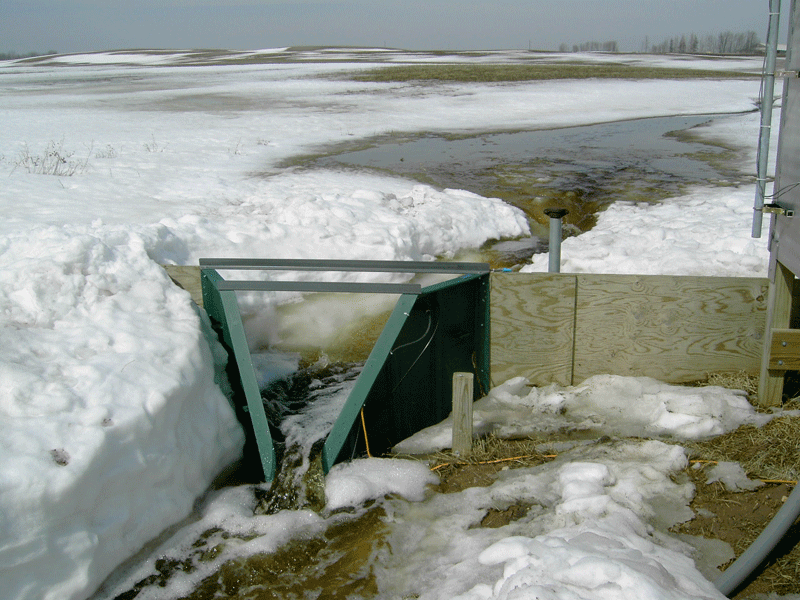Winter insights
IN-FIELD RESEARCH 365 DAYS A YEAR
It is important to note that research conducted in other jurisdictions, like the project outlined in the following article, provides Ontario farmers the opportunity to learn more about the risks and benefits associated with different farming techniques. Winter application of manure is not recommended in Ontario by the Ministry of Agriculture, Food and Rural Affairs (OMAFRA). The risk of stream pollution due to runoff increases when applying manure on frozen or snow-covered ground. Contamination of the environment is prohibited under the Environmental Protection Act, the Ontario Water Resources Act, and the federal Fisheries Act.

FOR MANY GROWERS, the winter months involve more office work and less time in the field. But for University of Wisconsin researchers, cold temperatures and blizzard conditions are not reasons to stay indoors. In fact, they manage field projects each day throughout the year to bring farmers useful information about what happens beneath the snow cover.
Eric Cooley, co-director of the university’s Discovery Farms program, says that not all frozen ground is created equal and that management decisions can be critical during this period. His program, led jointly by the University of Wisconsin — Madison and the University of Wisconsin — Extension, is focused on conducting environmental research on active farms throughout the state.
“Winter is unpredictable and field management is essential,” explains Cooley. “Our data tells us that over 50 per cent of annual run-off occurs on frozen ground, even though precipitation is much greater during the non-frozen period.”
DEMANDED DATA
As one of the first programs to implement year round research, Cooley’s team was able to collect questions and concerns from farmers and base their projects around providing answers.
While manure application during the winter months is a common practice, Cooley found that research on the related environmental impacts was in demand. “The topic of manure application was driven by incidences of significant nutrient losses during the frozen ground period,” he says.
Cooley says to manage the risks, it is critical for growers to understand which conditions lead to runoff and nutrient loss and which application decisions can most significantly impact water quality.
“Farmers are trying to minimize environmental impacts but maximize nutrient efficiency, so we are working to figure out those dynamics.”
SEASON TIMING
As a result of the Discovery Farms data, Cooley says it is critical that growers delay fall manure application until the soil temperature has cooled to 10 C or lower.
Ammonia applied before soil temperatures cool can result in nitrogen loss that can impact crop development as well as the environment. Cooler temperatures slow the conversion of ammonium to nitrate and therefore allow nitrogen to stay in the ammonium form longer. Cooley says this means nutrients are significantly more likely to stay in the soil and be available for the next crop. If applications need to be made before soils adequately cool, a nitrification inhibitor can be used to reduce the conversion of ammonium to nitrate.
“The early frozen ground period can be very good for manure application because the juices have an opportunity to infiltrate into the soil profile in many cases,” he says. But as winter progresses, he explains the challenge becomes keeping the nitrogen from being lost at the surface.
HIGH-RISK CONDITIONS
The team’s research findings note that there are three weather conditions that present the most significant risk of nutrient loss: concrete frost, ice crusting, and snow cover.
Concrete frost occurs when most of the pore space in the surface of the soil is occupied by frozen water. This can happen when there is rain or when there is a snowfall followed by a thaw that melts the snow cover. This condition decreases the soil’s ability to infiltrate water and nutrients. Cooley says if manure is then applied to fields, extensive movement of nutrients occurs because the soil does not have capacity to infiltrate.
When precipitation falls on soils that are very cold, ice crusts are formed. Researchers observed some crusts over one inch thick and Cooley says, like a skating rink on top of the soil, nearly 100 per cent of nutrients can be lost if applied during this time (depending on the slope and internal drainage within the field).
Thirdly, he says both the amount and condition of snow cover could present risks. If manure is applied on top of a few inches of snow, especially in early winter, the risk of loss is low. In mid to late winter, however, snow cover typically becomes very dense. When manure is applied during this time, there can be substantial losses simply because there is no contact with the soil.
Specific data findings and fact sheets related to the frozen ground period can be found at www.uwdiscoveryfarms.org. •







